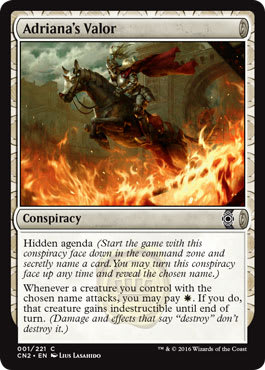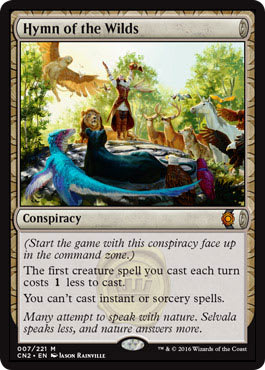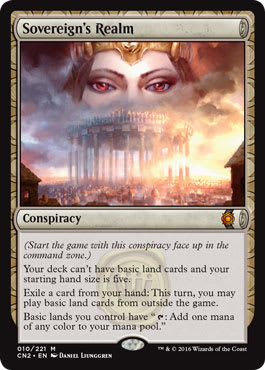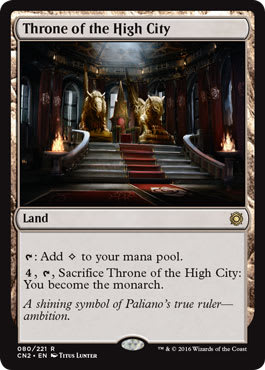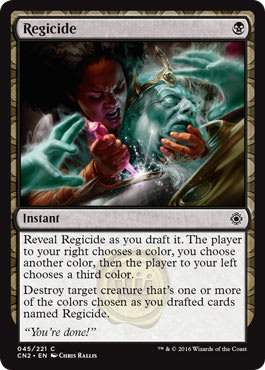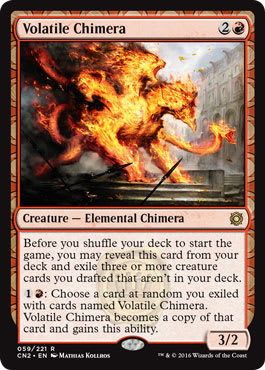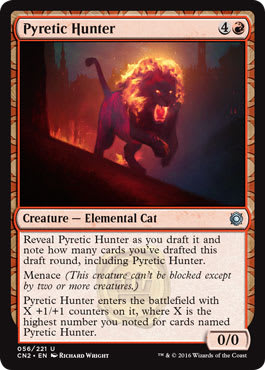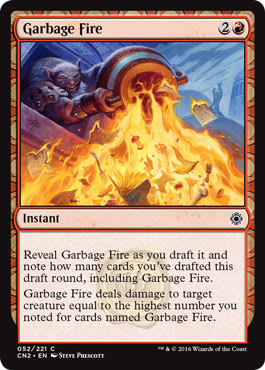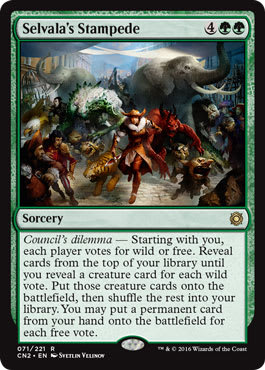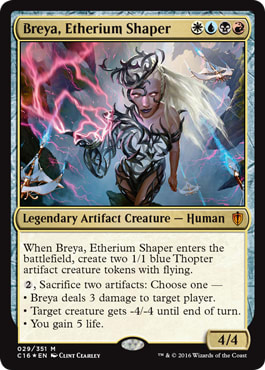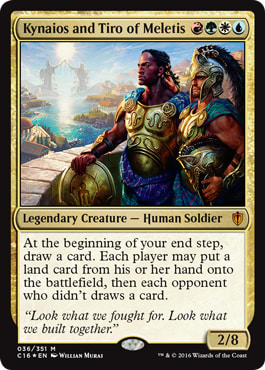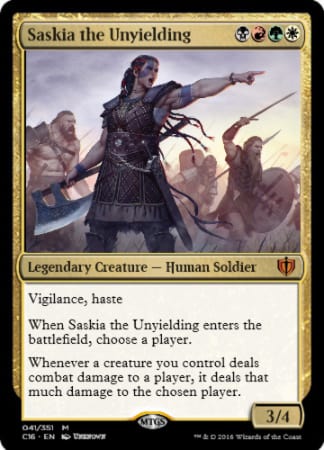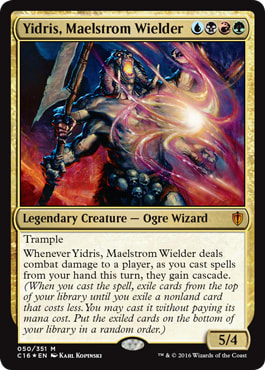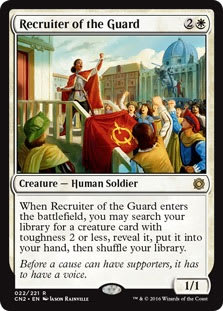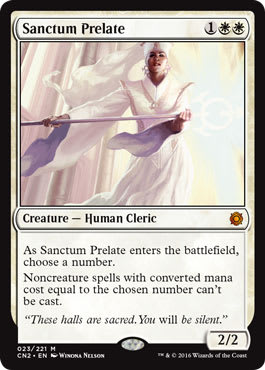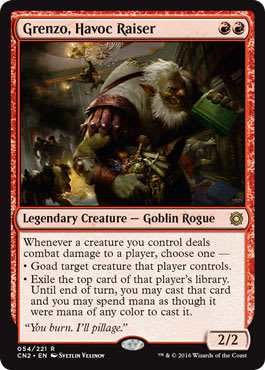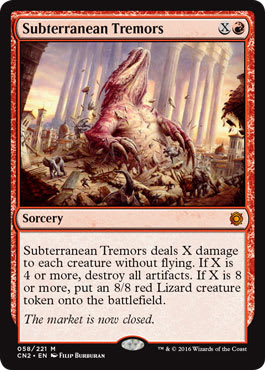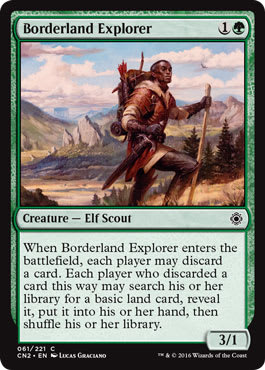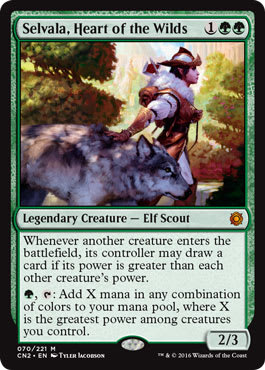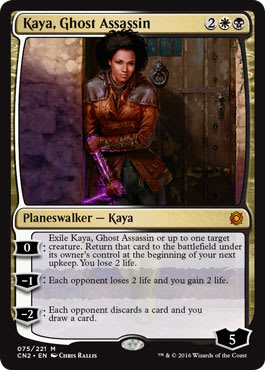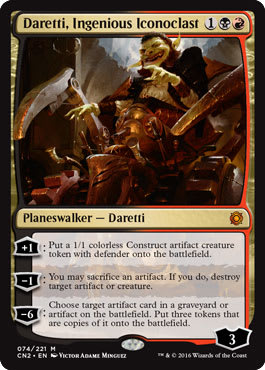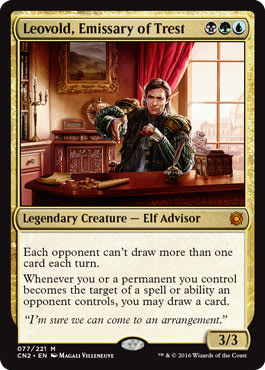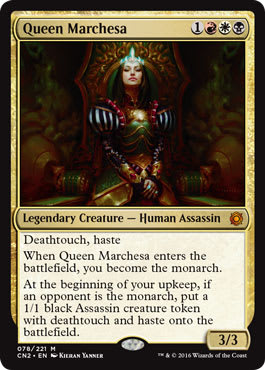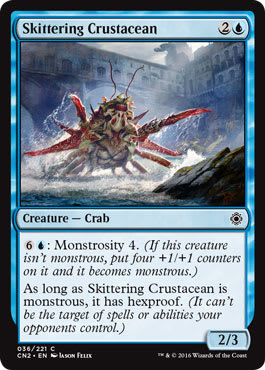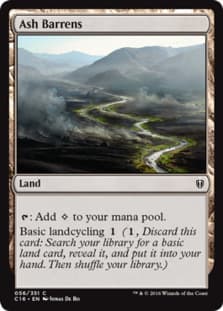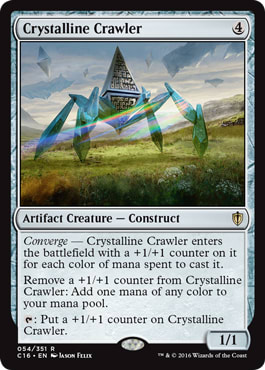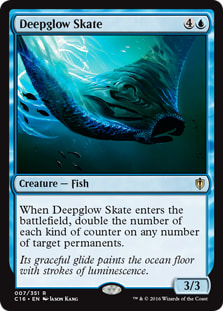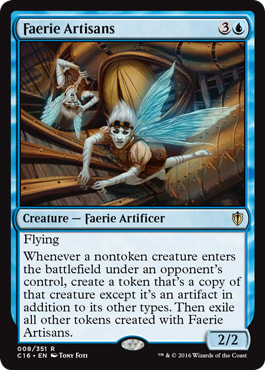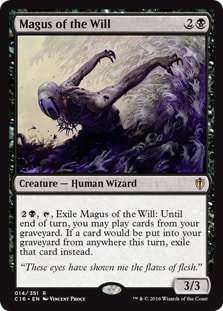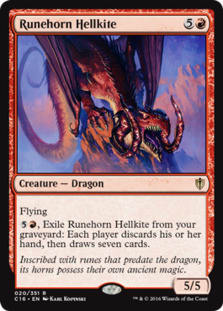Previous multiplayer sets like the original Conspiracy and Commander sets brought some cards like Dack Fayden, Fiery Confluence, and True-Name Nemesis, but due to the sets being centered around multiplayer, despite them being so that the cards don't have a chance to impact Standard, they can be pushed for Standard — as cards like Mystic Confluence and Unexpectedly Absent would dominate Standard if printed. Due to how True-Name Nemesis performed much better in Legacy than expected, recent multiplayer sets have had their “pushed” cards tempered in power level, but with that being said, how do Conspiracy: Take the Crown and Commander 2016 fare for Cube?
Like in previous articles, I'll be breaking these down by mechanics and non-mechanic cards.
CONSPIRACY: TAKE THE CROWN MECHANICS
The Conspiracies themselves.
I won't go into whether you should use them or not since that's ultimately your call. I know this sounds like a cop-out (and it probably is) but all in all, it's another one of the “macro” decisions that you can make as a Cube designer. A lot of early Cube articles talked about the distinction between including power and not, and while those can change the context of a Cube environment, there are other constraints like changing the dimensions of a Cube (more heavily weighted toward artifacts, multicolored, lands, ![]()
![]()
![]()
![]()
![]() , etc.)
, etc.)
Power-level wise, they all positively contribute to winning strategies (which is all we really want for Cube cards in the first place.)
Even the color-aligned conspiracies, while subtlety impacting the power of individual cards, look better than they appear since they don't require a deck slot and most boost the power level of individual creatures. Hired Heist, for example, can turn something as innocuous as an EOT Deceiver Exarch upgrades it into an Ophidian with flash, which is great for taxing resources of slower decks.
It wasn't until the MTGO Cube used Karakas that it started getting used more in Cubes, as the fear was the opportunity cost of the slot of upgrading a Plains in a deck wouldn't have enough targets in the average Cube match or would require it to be built around to an unrealistic manner, neither of which ended up being true. That said, there's a big difference between upgrading a plains to Karakas and marginally upgrading a White creature via Adriana's Valor (easily the worst of the cycle.) If you're looking to include these in a ![]()
![]()
![]()
![]()
![]() section, don't be surprised if some make it and some don't.
section, don't be surprised if some make it and some don't.
Side note: If you're still running Meloku the Clouded Mirror like the Cube Tutor Average 450-card Cube, since Illusion was a card (Illusion // Reality,) these cards get better, but it shouldn't be enough to sway one way or another.
Many of the others are similar — if you want to include them, it's mainly a question of opportunity cost against other cards. Some cards like Sovereign's Realm (not a combo with Backup Plan, per Matt Tabak) are riffs on cards like Worldknit where others like Emissary's Ploy can inspire new decks, like Mono-Blue aggro.
Monarch
The best cards for Cube with becoming the monarch have some utility in addition to being something that grants monarch. Oddly, it's similar to how the best Kaladesh Vehicles had the best of them do something in addition to just being a vehicle, to give them some utility outside of just their primary function.
Custodi Lich
As I referenced in the Kaladesh review, Black creatures at the 5+ mana range in Black aren't really competitive as there's been only a few high-tier cards like Shriekmaw and Grave Titan, with other cards occupying a secondary tier. Cards like Priest of the Blood Rite didn't really give enough payoff for the price that it asked to pay, but Custodi Lich is a good solid role filler.
It's similar to cards like Predatory Nightstalker and Nekrataal as a value creature. Its 2 toughness means that it generally trades down and that combined with making the opponent sacrifice makes it poor against decks that can pump out several small creatures, but even if it can (and has) backfire, generally it's been a lot of value for 5 mana by killing something decent, trading and getting some card advantage out of the deal.
Don't be surprised if you end up sideboarding these out in matchups where the opponent can get around potential blockers. Of course, that doesn't mean that Custodi Lich or other Monarch cards are bad if that's the case — see cards like Sulfuric Vortex or Shriekmaw vs Black-heavy decks, but just take caution of these scenarios when evaluating, as Custodi Lich is better than it may look.
Regal Behemoth
Similarly, outside of Primeval Titan, there hasn't really been a Green 6-drop that's been comparable. The Titan cycle was represented an unprecedented push for large creature power levels that we likely won't see for a while and it's likely going to be some time until we get a Primeval (or Grave) Titan-caliber 6-drop, and while colors like Red also have similar issues, it isn't as much of an issue because Red's aggressive stance means that it's not in the market as much as Green or Black. Cards like Greenwarden of Murasa are generally solid as they give a ton of value for Green decks, but are quite the power level drop from Prime Time.
Regal Behemoth operates on a similar basis as Custodi Lich as a dude that gives you the crown and its mana doubling ability lets it work similarly to Mirari's Wake — a card that has some immediate impact, but banks on the promise of being able to leverage the use of double mana. It's by no means Primeval Titan, but it's better than a lot of other Green 6-drops; so I've enjoyed it, but wouldn't be surprised if it doesn't last long in many Cubes if another great 6 comes out.
Throne of the High City
As a colorless mana producing land, this is a pretty non-commital way to become the Monarch since it can still be played on board states where the opponent may be able to just wrestle control of the monarch back. I've been pleasantly surprised at how well it's performed and a lot can be factored to it being a land that can be cashed in to become the monarch; think of it like a Mind Stone or a Horizon Canopy, but one that requires more resources to cash in. Decks like ramp decks that have enough ground pounders and tramplers tend to be able to cash Throne in for monarch sooner and control decks can also crack it on the opponent's end step while holding up mana to do things on the opponent's turn.
All in all, a solid land.
Melee:
Wings of the Guard
Years ago, 2/X fliers for 2 were considered “fine” for Cubes, cards that helped aggressive decks get in damage as aggressive deck support to get under control decks. We've seen cards like Selfless Spirit recently, but with the abundance of 2/Xs for 1 that we've gotten in the past few years, the role of these cards has diminished in Cube, as they're better at supporting the aggressive role, so cards like Mistral Charger are harder to find in many lists. Wings of the Guard's Melee essentially means that it's a 2/2 flying attacker — similar to Soltari Trooper. Unfortunately, having 2 toughness on attack doesn't really mean very much aside from meaning that it requires 2 Lingering Souls/Spectral Procession tokens to trade, but since it has 1 toughness when not attacking, it doesn't really mean much in the face of removal. While it's a solid consideration for Pauper Cube as Mistral Charger 2.0, it's an incredibly hard sell for other Cubes.
The other Melee cards don't really have the raw power for Cube, since while they were created to scale “fairly” for multiplayer games, they're just not efficient enough to really do much in Cubes.
Color-aligned “drafts matter” cards.
Paliano Vanguard
In Cube, tribal linear cards just aren't very good since there isn't a critical mass of cards that are impacted to make cards like Master of the Pearl Trident very good; I've talked about how the experiment to make Vampire tribal in the MTGO Cube a thing was looked upon with much skepticism from experienced Cube designers and many of those same people were unsurprised that it performed poorly.
The best tribal cards for Cube are the ones that stand alone on their own, like Goblin Rabblemaster, Siege-Gang Commander and Cloudgoat Ranger. Since Paliano Vanguard doesn't have any other impact aside from boosting tribals, we'll look at it in the context of cards like Master of the Pearl Trident.
Looking at the 450-card CubeTutor average list, we can see the following:
White:
- Human: 20
- Soldier: 11
- Knight: 5
- Warrior: 4
- Cleric, Spirit, Angel: 3
- Monk, Elemental, Giant: 2
- Hound, Kor, Wall, Artificer, Cat, Shapeshifter, Praetor, Ally: 1
Blue:
- Wizard: 9
- Human: 5
- Faerie: 4
- Rogue: 2
- Kor, Cleric, Jellyfish, Spirit, Merfolk, Artificer, Moonfolk, Elemental, Shapeshifter, Sphinx, Giant, Leviathan: 1
Black:
- Human: 7
- Vampire: 6
- Zombie: 5 (Grave Titan making zombies)
- Shaman: 4
- Demon, Warrior, Faerie, Rogue: 2 (Bitterblossom being one for Faerie and Rogue.)
- Spirit, Wizard, Faerie, Rogue, Rat, Praetor, Minion, Ally, Specter, Cleric, Assassin, Elemental, Giant: 1
Red:
- Human: 14
- Warrior, Goblin: 7
- Shaman: 4
- Monk, Artificer, Berserker, Elemental, Dragon: 2
- Satyr, Scout, Wizard, Vampire, Orc, Phoenix, Nomad, Kavu, God, Giant, Beast: 1
Green:
- Elf: 11
- Druid, Shaman: 8
- Human, Plant: 4 (Avenger of Zendikar)
- Ooze, Beast, Wolf: 3
- Wolf: (Master of the Wild Hunt, Garruk Relentless, Sword of Body and Mind)
- Beast: Garruk Wildspeaker, Beast Within
- Snake: 2
- Monk, Bird, Warrior, Spirit, Lhurgoyf, Scout, Centaur, Hydra, Giant, Elemental, Insect, Scout, Elephant, Treefolk: 1
Artifacts:
- Golem, Construct: 3
- Eldrazi, Horror: 2
- Wurm, Myr, Germ: 1
- (Thopters have 3 cards but no cards that specifically are thopters, making it a nombo — Pia and Kiran Nalaar, Whirler Rogue, and Pia Nalaar, the latter not (yet) in the average list.)
Other:
Non-white multicolored:
- Elf: 3
- Elder, Dragon, Human: 2
- Snake, Rogue, Beast, Satyr, Bird, Wizard, Devil, Goblin, Assassin, Berserker, Werewolf: 1
White multicolored:
- Wizard: 3
- Spirit: 2 (Figure of Destiny)
- Vampire, Elemental, Ouphe, Zombie, Cleric, Human, Dryad, Soldier, Cat: 1
Cumulative:
- Human: 53
- Shaman: 16
- Wizard: 15
- Warrior, Elf: 14
- Soldier: 12
White is the color that can utilize this card best, as it can have some various options for choices based on what's in your deck — like naming Soldier if your deck has a few Soldier token generators.
You may be wondering why so many mental calories are being expended on a tribal card — but it's to illustrate that it's not as good as it may look and how tribal linears just don't really work in Cube, unless you're looking to drastically change your Cube.
Regicide
Black has had a history of having cards that act as conditional removal for 1 mana — cards like Tragic Slip, Innocent Blood, and arguably Murderous Cut.
I've found that since it hits 3/5 of the colors, it generally hits about half of the targets in Cube — think of how conditional removal like shatter effects in artifact heavy draft formats like the Mirrodin blocks and Kaladesh played out. Cards like Natural State suffer in Cube because Naturalize effects naturally have Limited targets, whereas most Cube decks play creatures. I've liked it less than traditional removal like Go For the Throat, as a nice supplement to other removal, but it's certainly not a staple.
Smuggler Captain
This works as a riff on cards like Stoneforge Mystic; like a lot of recent Black 4s, it's more of a value creature than others and requires finding something for it, but that's generally fine; instead of being a 2/1 first strike that has Terror stapled to it, it instead acts as a weird style of tutor for that ![]()
![]() cost. Compared to standouts like Demonic Tutor, that rate isn't really that good, but people aren't playing Man-o'-War because Unsummon is so good, so we will need to temper our expectations accordingly. Like with Gonti, Lord of Luxury, who I've found has performed well in most Black decks, it being a value creature is nice and it's been mainly played in decks that want to get additional value either out of very powerful cards as a “2nd” copy of them, or to find silver bullets like Necromancy. There's some fear that it'll come around too late in the draft to matter, but I haven't found that to occur very much.
cost. Compared to standouts like Demonic Tutor, that rate isn't really that good, but people aren't playing Man-o'-War because Unsummon is so good, so we will need to temper our expectations accordingly. Like with Gonti, Lord of Luxury, who I've found has performed well in most Black decks, it being a value creature is nice and it's been mainly played in decks that want to get additional value either out of very powerful cards as a “2nd” copy of them, or to find silver bullets like Necromancy. There's some fear that it'll come around too late in the draft to matter, but I haven't found that to occur very much.
Animus of Predation
This is another card in the key word soup family that Soulflayer and Chromanticore are in, and while it does miss trample, there aren't really many Green creatures with trample in Cube anyway. When I did my Fate Reforged review, I showed that Soulflayer has a decent amount of targets, but most Cube decks will have issues making it work. Animus does help with that by not requiring you to draft around it, but to take cards that work well with it during the draft.
The problem with Animus lies with that same critical mass, where in theory, you just take a bunch of junk and make this strong.
But that fails on a few levels:
- This assumes that most targets will be in packs without anything else you'd want to take, which usually isn't true unless you're at the last few picks in a pack and even, that's very debatable.
- The number of keywords that you'd have to take to get this to be better than the average cube 5-drop in green, is critically high.
- Let's take Verderous Gearhulk for example.
- How many keywords would it take for Durkwood Boars to be better than Verderous Gearhulk? 2 isn't really enough. It's likely at least 3 (and even that depends as keywords aren't created equally – as Flying > Deathtouch, for example) and even that's a stretch.
Cards like the aforementioned Verdurous Gearhulk and cards like Nissa, Vital Force coming just in Kaladesh also make this hard to fit in, even if the average case works out.
Archdemon of Paliano
This is just all around bad. Since the card is playable in Eternal formats, there was likely a concern to not print an undercosted flier with no drawback in Legacy, so its 4 mana 5/4 flying body isn't really even that good to begin with; not even considering other great Black 4-drops like Kalitas, Traitor of Ghet and 4 mana 6/6 fliers like Abyssal Persecutor and Desecration Demon and the joke of getting it last pick and being forced to goofgrab several more picks lends little to the format or the enjoyment of a draft.
Per Matt Tabak, you can change the impacted cards between games in the sideboarding stages of the game, as each game has a “before you start the game” step.
Cards like Unexpected Potential, let cards “color bend” to add spice to a draft by making cards play much differently than they normally would, letting cards like Cryptic Command be played in a Mono-White deck. Cards like Volatile Chimera, Arcane Savant, and Caller of the Untamed work in a similar fashion.
Volatile Chimera operates similarly to “big dumb monster” a Exalted Angel that starts out as a pretty mediocre creature but has a potential to get much larger. I've found that most Red decks won't play it unless there's 3 large creatures to combine it with, to make sure that rolling the dice doesn't result in a whammy, but I've found that it isn't very hard either for those decks to find 3 targets to copy. Even something with a highly impactful enters-the-battlefield trigger with a big body, like Angel of Serenity, is still fine to hit as a 5/6 flier for ![]()
![]() +
+ ![]()
![]() isn't a bad rate, but a deck playing it likely will want it as a card that isn't the ceiling for it. While Red 3s have been getting better, especially for attack decks, this is a standout.
isn't a bad rate, but a deck playing it likely will want it as a card that isn't the ceiling for it. While Red 3s have been getting better, especially for attack decks, this is a standout.
Arcane Savant is the clear winner of these cards. Its Sea Snidd body isn't making waves and even without playing cards that few decks want, like Cruel Ultimatum, it's still a very powerful 5-drop in Blue. Not even accounting for it being able to copy things outside of its color (like Volatile Chimera can do with cards like Elesh Norn, Grand Cenobite and Griselbrand) to access things that a deck may not normally have access to, like Enlightened Tutor in an Izzet control deck, it generally creates an absurd amount of value, as I've seen it copy things like Wretched Confluence, Spectral Procession and Seasons Past, all to great effect. Even something as innocuous as Lightning Strike lets it act as a Flametongue Kavu and one of the few reasons I can see to not include it in Cube is if you're worried about power level, but if your Cube is designed to handle it, it's an easy include.
Caller of the Untamed on the other hand, doesn't warp mana costs like Volatile Chimera or Arcane Savant and while it compares to cards that never see Cube play like Soul Foundry, it's a solid addition to Green value decks as it comes with a body. I've found that it can generate a lot of value if it lives and being able to copy something with a powerful enters-the-battlefield trigger like Skinrender can help Green midrange and ramp decks to get to the later stages of the game. Like Chimera and Savant, Caller can also help to shore up some weaknesses in the color, giving it access to removal creatures like Skinrender and Flametongue Kavu. It can require some setup to keep it alive and to protect it, but I've found most Green decks have liked Caller of the Untamed.
Other draft-matters cards:
Pyretic Hunter
This is an upgrade to Lurking Automaton as a giant creature with no immediate impact and at least having some evasion to show for it. The question is how big does it really need to be to be worth using? I'd wager that it's at least 7, using something like Kalonian Hydra as a comparison. If it reaches higher numbers, as cliché as it sounds, it doesn't really have a way to protect itself or provide immediate value and while menace is an underrated form of evasion,
Garbage Fire
This can act similarly to a ![]()
![]() Terminate, similarly to how Skred in Cubes that would count basic lands as snow-covered basics, but it's just too inefficient mana-wise to really be worth it, even with the reality that it will inevitably go late and therefore deal about a billion damage.
Terminate, similarly to how Skred in Cubes that would count basic lands as snow-covered basics, but it's just too inefficient mana-wise to really be worth it, even with the reality that it will inevitably go late and therefore deal about a billion damage.
Council's Dilemma
Selvala's Stampede
The only Council's Dilemma card that has the power to compete in Cube. Like with Melee, a lot of the cards are meant to scale up in multiplayer and lots of these cards just don't stack up well. Selvala's Stampede works well in the Green ramp decks that play cards like Oath of Druids, where they play only a few high-impact creatures but ones that are great value and can take over the game. Being 6 mana means that it can't just cheat something into play, but it's a nice supplement for ramp decks those decks, as it also provides the possibility to just cheat something from the hand into play.
COMMANDER 2016 MECHANICS
4-Color commanders:
4-color aren't explicitly new cards and not really any kind of mechanic. But, as the Nephilim have been miles from making many Cubes and with the new class of 4-Color legends being much better, there's a question of whether you want to include them in your Cube.
Tri-color cards tend to not have many slots in them for Cube as the number of decks that want to play them are quite low, since it requires hitting a specific triad and while you wouldn't be surprised to see something like a R/W aggro deck or a U/B control deck, it's more surprising to see something like a Mardu midrange deck in a draft pod. Because of this, the demand for 4-Color commanders is much lower.
It isn't to say that these cards are “bad” and unfortunately, the trend toward overly reductionist language tends to constrain critical thought into saying that these cards are bad, as when looking at a card like Atraxa, Praetors' Voice, a 4-mana 4/4 flier with the ability to proliferate and a bunch of other keywords is powerful in the decks that want to play it.
But that's where it really comes down to — not many decks are really going to want to play this and these cards being included in your Cube depend on whether you want to explicitly support 4 and 5 color strategies — and most Cubes really don't, due to the opportunity cost of including something that can more easily fit into most Cube decks.
Partner:
Unless you're using house rules or errata for allowing commanders somehow, the Partner text, like the commander text on Daretti, Scrap Savant, is flavor text. Like with Daretti, Scrap Savant and Freyalise, Llanowar's Fury, it loses some functionality. Most of the Partner cards, power-level wise, just aren't that great, but there's one standout:
Vial Smasher the Fierce
It's true that Vial Smasher is a 3-mana creature that has no immediate board impact, and we'll assume that it's not going to be easy for decks to immediately have something to trigger its damage-causing ability, but over the course of the game, it should. Its stats aren't really that great and it's true that cards that have “if you untap with them, they do a lot” tend to look better than they actually play out.
But taking that into consideration, how does Vial Smasher play out?
I found that although it suffers from “dies to Lightning Bolt” syndrome, it isn't hard for it to act as a recurrent damage source, and it isn't out of the question for a B/R deck to play cards like Tasigur, the Golden Fang, Fireblast, and Snuff Out — all cards with high converted mana costs that never get played for retail. Since a Blind Phantasm isn't really that impactful on its own and if played in a deck like a B/R midrange deck, it dealing damage may not even matter that much. This makes it more for aggressive decks and despite having no immediate board impact, I've found the lasting impact that it has can be high. Rakdos has cards like Kolaghan's Command and Daretti, Ingenious Iconoclast, but aside from that, there isn't really that much that's very exciting — Dreadbore, Murderous Redcap, etc. Don't be surprised if this ends up making your Cube.
CONSPIRACY: TAKE THE CROWN CARDS
Recruiter of the Guard
This works very similarly to Imperial Recruiter since it's a tutor for small creatures on a stick. When I tallied the targets, numbers-wise, they weren't really that different, as the Cube Tutor 450-card average has 104 targets for both.
Differences:
Wall of Omens, Fiend Hunter, Deceiver Exarch, Meloku the Clouded Mirror, Drana, Liberator of Malakir, Vampire Nighthawk, Gray Merchant of Asphodel, Sylvan Caryatid, Wall of Blossoms, Wall of Roots, Courser of Kruphix, Reflector Mage, Shadowmage Infiltrator, Trygon Predator, Spellskite
Flickerwisp, Accorder Paladin, Porcelain Legionnaire, Vendilion Clique, Oona's Prowler, Shriekmaw, Hellspark Elemental, Alesha, Who Smiles at Death, Flametongue Kavu, Hero of Oxid Ridge, Bloodbraid Elf, Kitchen Finks
Like in my review of Kaladesh when comparing Torrential Gearhulk to Goblin Dark-Dwellers, pure numbers-wise, Imperial Recruiter wins, albeit, barely. One could argue just how different how Red and White would get more value out of a non-aggressive 3-drop since, while White supports aggressive decks incredibly well, it doesn't tend to lean quite as aggressively as Red.
One could also argue that Vendilion Clique, Shriekmaw and FTK are better tutor targets than Courser of Kruphix, Reflector Mage and Spellskite.
Regardless, all things being considered, they're about the same in terms of function and power level. Both work well to act as a mini-tutor which have a surprisingly higher number of targets than you'd initially think and with more solid and efficient creature threats coming out, it's just going to get better with age (unlike something like Stoneforge Mystic which has a mostly set power level cap due to WoTC's reigning in their power level.)
Sanctum Prelate
This suffers by making it so that it's hard to really nail much with it, but it can help to punish some decks. Naming 4 as the mana cost helps to stop wraths and a lot of the best Planeswalkers, and naming either 1 or 2 helps it to stop some of the most powerful spells and spot removal and spells in the game. That said, it doesn't really do much on its own and while it also impacts you, the competition's just getting better and it's hard to justify in a Cube with cards like Recruiter of the Guard essentially taking the card slot that Sanctum Prelate would.
Stunt Double
“Yet another Clone,” and as few Cubes outside of peasant play Clone, it's competing with cards like Sakashima's Student, as Phantasmal Image and Phyrexian Metamorph are top-tier clones that are staples in many lists. One could argue that Sakashima's Student was in an awkward position as a card that wanted to work in a deck with a critical mass of smaller creatures to enable it being able to be ninjutsued early out and in Blue, that didn't amount to many decks. People joke that flash is “Blue haste” and the closest analog is Dack's Duplicate (as Dethrone was mostly flavor text.)
But as cliché as it sounds, Blue 4-drops are pretty hard to find room for and one that requires having something else to copy, makes it so that a 4-drop that can be reasonably argued as being situational is hard to find room for.
Grenzo, Havoc Raiser
A solid supplement to the great Red 1 and 3-drops we've been getting for Cube lately. It's an on-color card that plays similarly to Edric, Spymaster of Trest by letting chip shots act draws, even if they're in the vein of “yolo draw” style of cards like Chandra, Torch of Defiance and Outpost Siege (following the Chandra style of being unable to play lands.) Since it requires the cards being cast on the same turn, being able to “draw” 3 cards from 3 triggers means it can behave closer to having card selection than pure card advantage, but it's still very good.
Goading is also useful by making it so that creatures need to suicide into your larger threats, which is somewhat unlikely in a Red aggressive decks, so it's more to clear future blockers out of the way. With the exception of Thriving Grubs, most of the 2-drops we've gotten are more utility creatures than 3-power creatures for 2 and because of that, it supplements straight-up attackers like War-Name Aspirant and the more flexible ones like Abbot of Keral Keep and Mogg War Marshal.
Subterranean Tremors
This is in a weird spot for Cube, as “big Red” decks like Wildfire decks tend to have mana rocks like Mind Stone and signets, so casting it for 4+ mana can do more damage to your own board state by Shatterstorming all of the artifacts away.
Cubes that don't run as many mana rocks can definitely get more mileage out of it, but it's more for control decks that don't rely as much on them. There's been a lot of talk about how signets are too good for Cube (which I've found isn't true at all) but even in decks with a signet or two, it still works well in slower Red decks as, it can act as a cheap wrath effect that can scale up. Generally, it doesn't create an 8/8 but it's a nice mana sink if need be.
As non-aggressive Red cards don't populate a high % of Red cards, it offers some nice utility for those slower Red decks, since it's nice to have a wrath that doesn't hurt you for decks that use their life total as a resource.
Borderland Explorer
Decent for acting as a style of B/G card to dump something in the graveyard and unlike something like Mulch, it can be cast on curve and have real board impact. It's arguable that graveyard decks aren't in the market for a 3/1 for 2 and that the symmetry could help the opponent more than you (since once you cast it, you have to let it happen.) But it's still a nice way to encourage those kinds of graveyard decks. Finding cross synergies between graveyards and aggression is difficult to find and cards like Gnarlwood Dryad can help to encourage Green aggressive decks, but if you're not doing so, don't be surprised if you don't include this in your Cube.
Selvala, Heart of the Wilds
Another riff on cards like Somberwald Sage and Shaman of Forgotten Ways as a way to bolster Green ramp by generating mana for creature spells. Like the others, she synergizes well with mana elves to be cast on turn two and it's not difficult for her to start drawing cards, since she can help to power out larger creatures, which help to keep providing fuel for creatures. I've found that it's not that difficult for her to draw cards and, like a few other 3-drops referenced, is another of the “if you untap with this, your chances of winning increase,” and helps to generate mana for mostly-Green decks that splash for other colors, due to Green's easy access to mana fixing. She's a solid addition for Green ramp decks if you're looking to give those decks some love.
Kaya, Ghost Assassin
A solid B/W Planeswalker that oddly compares to a constant damage source like Sulfuric Vortex and Venser, the Sojourner. She unfortunately doesn't work quite as well as the various Sorins as the 4-mana Sorins work well in all decks, Sorin, Grim Nemesis is a solid B/W control finisher, but Kaya, Ghost Assassin works as a game-ender or a blinking recursive threat. Most cards that tend to work by blinking tend to be a bit too slow for Cubes without explicitly supporting them, but she's a great way to encourage those types of decks but likely falls short of the Sorins for many Cubes.
Daretti, Ingenious Iconoclast
The 2nd best B/R card next to Kolaghan's Command. Initial impressions were that Daretti needs to be in an artifact-centered deck, but I've found him to be great even in B/R decks that don't really care about artifacts. Being a 3-mana Planeswalker that generates blockers is great to stall for the late game, but I've found that even in faster B/R decks, while that's not his optimal home, being able to generate artifacts for his aggressively costed -1 ability helps to kill opposing blockers or the occasional non-creature artifact. His ultimate is pretty lackluster if you don't have anything worth copying, but I've found that his ability to generate an absurd amount of value makes him a top-tier Rakdos card.
Leovold, Emissary of Trest and Queen Marchesa
Like with the 4-Color Commander 2016 cards, tricolors need to do a whole lot in Cube to really be worth it, to make up for the fact that many decks just don't want them, as they require a very specific triad to be hit. Because of this, while both of these do what they do relatively well, since they occupy a slot where only a few decks can realistically play them, it's more a question of whether it's something you want to explicitly include.
LASTLY
Sinuous Vermin and Skittering Crustacean. While none of these monstrous cards have a hope of making non-Pauper Cubes, I wanted to briefly mention them as they're incredible adds for Pauper Cube. The format tends to have an issue with a lack of powerful big creatures (unlike in Cubes with rares) and because of this, both of these creatures bridge the gap between early beaters and late-game threats. Skittering Crustacean is great for getting around all of the efficient spot removal in the format and I've been very impressed with both.
COMMANDER 2016 CARDS
Ash Barrens
This is the only new common from Commander 2016 and thankfully, fits most Cubes (even non-Pauper ones) like a glove.
A lot of cycling cards don't tend to see much play in Cube because while a lot of cycling cards operate on an axis of having a pretty mediocre card with cycling (so that it can be jettisoned if the game state dictates that it'd be weak) and the only one with widespread Cube use is Miscalculation, which operates on an axis that works well enough in most decks anyway in Cube.
Obviously, Lay of the Land hasn't been Cubeworthy since, well, ever but we've learned that when the overall package of a card works well, it doesn't really matter if some modes aren't very efficient. After all, is drawing a card from Miscalculation for 2 mana a good rate? Is casting Secure the Wastes for ![]()
![]() to make a 1/1 efficient? Not really, but having that option is nice.
to make a 1/1 efficient? Not really, but having that option is nice.
Like with the Bloodrush cards, while it does offer a few modes, you're “locked in” after using it, so if you cast a Rubblebelt Maaka as a Hill Giant, there's not much else that you can do to re-gain that flexibility. Ash Barrens works similarly, since its primary mode is to basic landcycle and its secondary mode is to play it out as a land, as playing it out as a Wastes makes it a poor land to play, since it's poor at helping to cast spells since it taps for colorless. Ash Barrens' secondary mode does help you to cast and enable Oath of the Gatewatch's Eldrazi, and while that's a part of the equation, it isn't a main draw to playing it out.
I've heard comparisons to cards like Terramorphic Expanse and Evolving Wilds as both lands are common lands that are pretty slow ways to find another basic land.
But the more I thought about how the card actually plays out, as an instant Lay of the Land, I realized that it acts more like a spell than a land. Experienced Cube players know to place Maze of Ith with their spells instead of toward their land count, since it doesn't help to cast spells. When I looked at reviews of this card and asked people if they'd consider it a land, their context for evaluation was to treat it as a land, not a spell. It intuitively makes sense, because both modes make mana, but I found that evaluating the card in that context didn't really show how it was playing out, since it was generally played as Lay of the Land primarily and only really played out as a land in rare scenarios.
Like Terramorphic Expanse and Evolving Wilds, both go to the graveyard and can fetch (or act as) Wastes, so they act similarly in that way while subtly interacting with cards like Crucible of Worlds, delve cards like Dig Through Time and others, but in general, I've found Ash Barrens is more spell than land.
So what does this really mean? Does it mean that it's better or worse than the common fetchlands? Well, it isn't necessarily better or worse, but different. Decks that curve out will have a harder time landcycling, but it's a great way to make sure that those decks have access to fixing via another spell to do so and while it's not incredibly efficient, it's still great for those decks, so don't be surprised to see this making an impact in Cubes for a while.
Crystalline Crawler and Prismatic Geoscope
Both of these cards work as relatively high-cost mana rocks that don't really do much when they resolve, but promise to reward you for that by getting you get a lot of value if you untap with them. In this vein, Crystalline Crawler can use mana from its counters to cast something to protect and can grow itself. Prismatic Geoscope means that it likely will tap for 3 mana in decks that will want to play it, as a deck like your average U/W control deck won't really want to and playing a few random duals to super-charge this isn't really worth it and because of that, will make it a bit slow for many Cubes, but Crystalline Crawler should be easier to include in your Cube. However, it may be hard to include in your Cube as we've already got 4-mana mana rocks like Thran Dynamo, Everflowing Chalice, and Hedron Archive, so don't be surprised if you don't have room for it, despite how well it plays out.
Boompile
Boompile offers to be a Nevinyrral's Disk type of card, but as it fails 50% of the time. It's true that it stays around if it fails out, but considering that being able to wrath at a moment's notice is a strength of those types of cards, it's not really worth it when the mana cost isn't really a bargain either.
Selfless Squire
An interesting Fog variant which can have a large creature but is too variant to compete successfully with White's existing 4-drops.
Deepglow Skate
Double double, toil and trouble. Wait, I'm too late for Halloween references. The main talking point of this card that is that it combines incredibly well with Planeswalkers as most 4-mana Planeswalkers ultimate immediately once their counters double and let's be honest, most of the value out of this card is from Planeswalkers. Doubling Season has been a fringe casual card that never really broke out of its casual roots (aside from some fringe Modern brewing) and because it lacked immediate impact, it never really had much traction in Cube. Being a creature helps with the possibility of being a stone blank, but generally playing it as a Sea Snidd is poor and when we're getting Arcane Savant, it's harder to justify. Its ceiling is absurdly high, even with just one Planeswalker, but it having a high probability of missing makes it hard to include for Cube.
Faerie Artisans
This lets you double up on ETB triggers from opp. They get to choose though and as a 4-mana Blue card which has a bevy of great spells and creatures, it's a rough sell. It's arguable that this is significantly worse than something like Dungeon Geists, which tends to get underrated in Cube, which makes it a very long shot for Cube.
Magus of the Will
Similar to Magus of the Wheel, which appears to have fallen out of favor in the past few years due to the recent solid additions to Red 3-drops (Hanweir Garrison, Sin Prodder, Pia Nalaar, Volatile Chimera, etc.)
Black doesn't have this same embarassment of riches:
Top-tier: Drana, Liberator of Malakir, Vampire Nighthawk, Ophiomancer, Flesh Carver, Liliana, Heretical Healer, and Hypnotic Specter (the latter showing some age.)
As previously mentioned, a weakness of the Cube Tutor averages is that they can lag behind and although that average only notes 4 Red 3-drops (Alesha, Who Smiles at Death, Chandra's Phoenix, Goblin Rabblemaster, Guttersnipe) with some others that could very easily make this average (Imperial Recruiter, Feldon of the Third Path.)
But honestly, that's really it and it's not as deep in Red, so while it may be tempting to compare it directly to Magus of the Wheel (since there aren't many cards that are similar to it and thus, that's where the mind goes) — while it's not quite apples to oranges, it's closer to oranges and lemons.
How good is the card itself? Like with Magus of the Wheel, the opponent sees it a mile away and it doesn't offer a cost discount, but being a creature lets it have uses by being a decently sized creature. Yawgmoth's Will typically functioned like an X burn spell and Sphinx's Revelation that could be cast early, but generally wanted to be cast later to get a lot of value and this being a body helps with that. That said, it can be kind of slow in decks that don't have a lot of cheap things to bring back, which I've found through trying the card out, but honestly, that same thing would have applied with Yawgmoth's Will. It isn't absurdly powerful like some of the recent White 3-drops but then again, Black doesn't really have many and can use the help that it can get there, making it a nice addition.
Frenzied Fugue
Threaten effects traditionally have a hard time in Cube since Red aggressive decks require a critical mass of small creatures to be adequately supported in Cube and once you get past the small creatures, burn and Planeswalkers, there just isn't much room left for miscellaneous cards like that (I even found including Act of Treason and Traitorous Blood in my Pauper to be difficult due to the high quality of burn spells, but I was able to make it work.) Frenzied Fugue instead hits any permanent — Planeswalkers included — to clear a path for attacking creatures.
Cards like Zealous Conscripts already work on that axis, but tends to see Cube rates of adoption lower than its power level implies because Red 5s are pretty scarce and many other Threaten types of cards like Harness by Force, as good as it is, had hard times competing with burn (let alone other high-cost ones like Word of Seizing.) Due to Red's aggressive stance, Red 4-drops tend to be curve toppers like Hero of Oxid Ridge, Hellrider and Koth of the Hammer. That said, I've been pretty impressed with how well Frenzied Fugue gets potential blockers out of the way and doing so for future turns. One of the ways that Threaten effects tend to be used when non-alpha striking is to get a big blocker out of the way and attack with it, getting the opponent to a low enough life so that subsequent attacks get through.
Frenzied Fugue works well on that axis as well. The opponent does get the creature back and for some creatures like Wurmcoil Engine and some titans, having that creature back can help, but having such a lasting impression on the board can be extremely helpful for getting those last few points of damage in. It's true that it does cost an additional mana over cards like Threaten and it's very easy to dismiss an additional mana when it can turn a card from being solid to mediocre, but the added utility makes up for it, making it a solid addition to Red attack decks.
Runehorn Hellkite
Another card that's mediocre when in play but offers a payoff if it dies. It's unfortunate that doesn't have haste (else it'd be a contender) but with not much impact, it doesn't have a home in either Red aggressive decks or slower Red decks, as its wheel of fortune ability requires it to die.
Stonehoof Chieftain
An 8-drop with little immediate impact, but can help push other large creatures in combat. But with many 8-drops like Craterhoof Behemoth, Woodfall Primus, Terastodon, and Decimator of the Provinces (being close to 8-mana with Emerge) providing immediate, game-altering impact, having something that only does given certain circumstances, it's not competitive with those options.
I hope you've enjoyed this analysis of Conspiracy: Take the Crown and Commander 2016 for Cube. Thanks for reading!
My Pauper and powered Cube lists.
Cube podcast, The Third Power, that Anthony Avitollo and I host.













